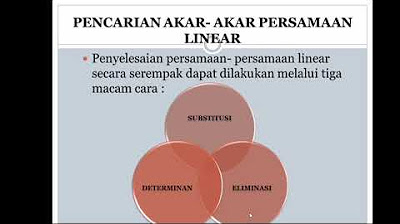Basic Circuits Math - Using Substitution and Matrices to Solve Circuits Equations
Summary
TLDRIn this video, the presenter discusses two methods for solving circuit math problems: the traditional substitution method and a matrix calculation approach using a linear equations calculator. They share their personal struggles with math and demonstrate how to apply Kirchhoff's Current Law (KCL) to set up equations for a sample circuit with resistors and voltages. The presenter simplifies the equations step by step, showing the process of substitution, and then contrasts it with the matrix method, which is faster and less error-prone. They emphasize the importance of having an intuitive understanding of the circuit's behavior, regardless of the method used.
Takeaways
- 😀 The speaker initially avoids math tutorials due to a lack of confidence in their math skills but decides to discuss circuit math.
- 🔍 The video focuses on two methods for solving circuit equations: the substitution method and the matrix method.
- 📚 The substitution method is demonstrated first, showing a step-by-step approach to solving for voltages in a circuit without a calculator.
- 🧩 The matrix method is introduced as a more efficient way to solve circuit equations, especially when using tools like a linear equations calculator.
- 🤔 The speaker emphasizes the importance of understanding the intuitive feel of the math involved in circuits, ensuring the results make sense.
- 🔢 The substitution method involves simplifying equations and substituting values to isolate variables, which can be prone to errors.
- 📉 The matrix method simplifies the process by inputting the equations into a calculator, reducing the chance of manual calculation errors.
- 🛠️ The video provides an example circuit with resistors and voltages to illustrate the math involved in solving for unknowns.
- 📝 The speaker discusses the process of using Kirchhoff's Current Law (KCL) to set up the equations for the circuit.
- 📉 The matrix calculator on circuitbred.com is recommended for those who prefer a tool-assisted approach to solving circuit equations.
- 💡 The video concludes by encouraging viewers to practice both methods, understanding the foundational concepts and the practical application of circuit math.
Q & A
What was the initial stance of the speaker on creating math tutorials for the Circuit Bread channel?
-The speaker initially stated that they would not create math tutorials for the Circuit Bread channel due to their self-acknowledged lack of strength in math and the embarrassment of making mistakes on camera.
What is KCL in the context of the script?
-KCL stands for Kirchhoff's Current Law, which is a fundamental principle used in circuit analysis that states the sum of currents entering a junction or node is equal to the sum of currents leaving the node.
What is the purpose of the example circuit provided by the speaker?
-The example circuit is used to illustrate the process of solving circuit equations using two different methods: substitution and matrix calculation, to help viewers understand how to deal with the math that comes from circuit problems.
How many resistors are in the example circuit, and what are their values?
-There are four resistors in the example circuit with values of 100 ohms, 200 ohms, 300 ohms, and 400 ohms, labeled as R1, R2, R3, and R4 respectively.
What are the two methods discussed by the speaker for solving circuit equations?
-The two methods discussed are the substitution method and the matrix calculation method, with the latter involving the use of a linear equations calculator.
Why might the substitution method be preferred in some educational settings?
-The substitution method might be preferred in educational settings because it provides a hands-on approach to understanding the process of solving equations, which is often a requirement in school curriculums.
What is the main advantage of using a matrix calculator for solving circuit equations according to the speaker?
-The main advantage of using a matrix calculator is that it is faster, less prone to manual calculation errors, and can handle more complex equations with multiple unknowns more efficiently.
What is the speaker's recommendation for dealing with complex algebraic errors during manual calculations?
-The speaker recommends taking one's time, being careful, and learning to double-check work to avoid algebraic errors during manual calculations.
What is the significance of having an intuitive feel for the circuit equations being solved?
-Having an intuitive feel for the circuit equations is important to ensure that the results make sense in the context of the circuit's behavior and to quickly identify any potential errors in the calculations.
How can viewers get help or ask questions about the content of the video?
-Viewers can ask questions or seek help by leaving comments on the YouTube video, visiting the CircuitBred.com website, or joining the new Discord channel mentioned by the speaker.
What is the speaker's final encouragement for viewers who found the tutorial helpful?
-The speaker encourages viewers who found the tutorial helpful to like the video, subscribe to the channel, and share it with friends.
Outlines

このセクションは有料ユーザー限定です。 アクセスするには、アップグレードをお願いします。
今すぐアップグレードMindmap

このセクションは有料ユーザー限定です。 アクセスするには、アップグレードをお願いします。
今すぐアップグレードKeywords

このセクションは有料ユーザー限定です。 アクセスするには、アップグレードをお願いします。
今すぐアップグレードHighlights

このセクションは有料ユーザー限定です。 アクセスするには、アップグレードをお願いします。
今すぐアップグレードTranscripts

このセクションは有料ユーザー限定です。 アクセスするには、アップグレードをお願いします。
今すぐアップグレード関連動画をさらに表示

5 MTK EKO PENCARIAN AKAR AKAR PERS LINEAR

Matrices (cayley Hamiton Theorem) IN HINDI Part No 04 As Per New Syllabus (N O C )

Kurikulum Merdeka Matematika Kelas 9 Bab 1 Sistem Persamaan Linear Dua Variabel

Materi Matematika Kelas 8 : Sistem Persamaan Linear Dua Variabel (SPLDV)

ACT Calculator Strategies TI-84+

Matematika kelas X - Sistem Persamaan Linear part 1 - Sistem Persamaan Linear Dua Variabel (SPLDV)
5.0 / 5 (0 votes)
